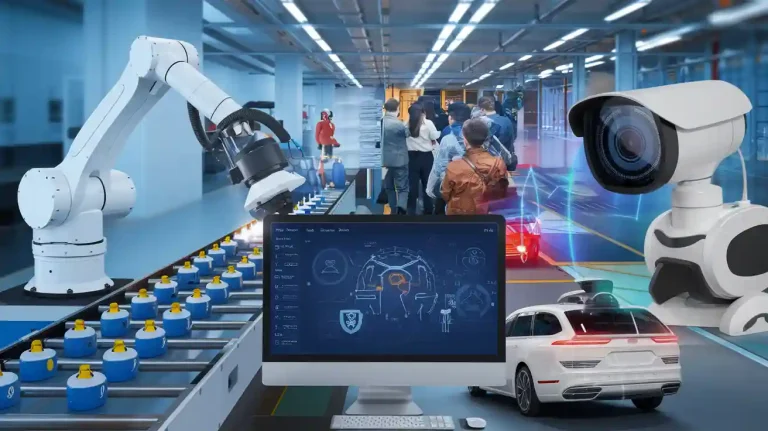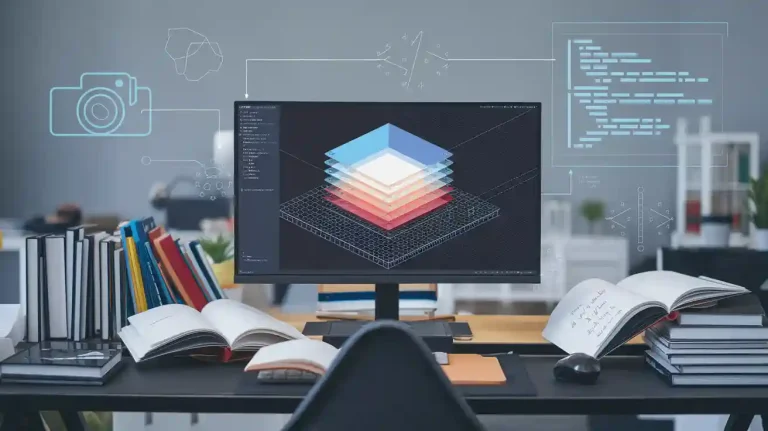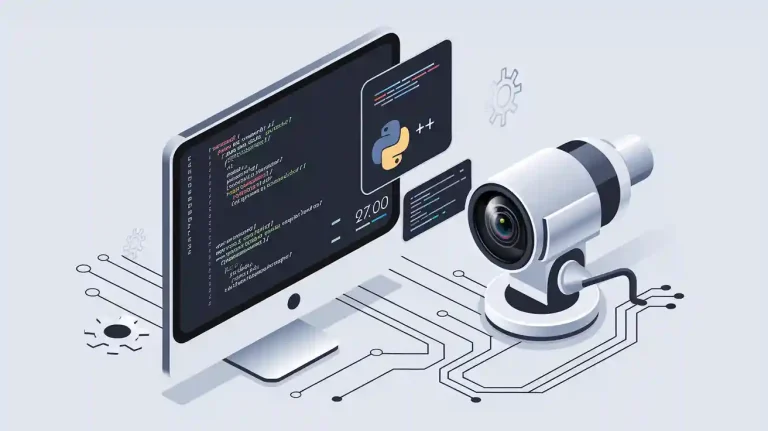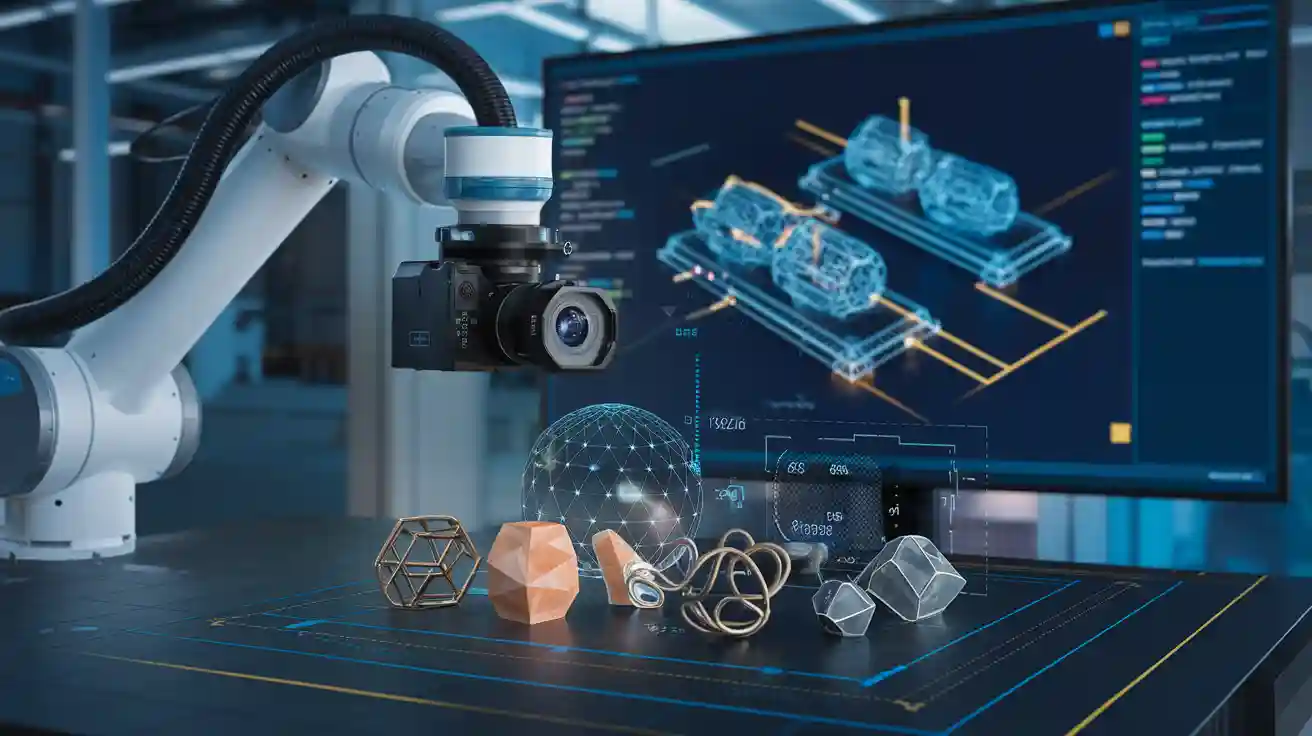
An object space machine vision system uses specialized imaging to capture real-world objects with accurate spatial relationships. This system maps images so that distances and sizes in the image match those in the real world, making precise measurement possible.
- Manufacturers use an object space machine vision system for tasks like object detection, defect identification, and barcode reading.
- These systems help track vehicles or people, support inventory management, and enable fast, reliable decisions in automated environments.
Key Takeaways
- Object space machine vision systems capture images that match real-world sizes and distances, enabling precise measurements.
- Telecentric lenses keep image size constant, removing distortion and parallax errors for accurate and repeatable results.
- These systems improve factory automation by detecting defects, guiding robots, and speeding up quality control with high accuracy.
- They support 3D vision and robotics, helping machines build detailed models and perform complex tasks with real-time feedback.
- Regular calibration and stable lighting are essential to maintain measurement accuracy and system performance.
Core Principle
Real-World Spatial Mapping
Object space machine vision systems create a direct link between the real world and digital images. These systems use special lenses and cameras to capture objects so that their size and position in the image match their actual size and position. The system ensures that every point in the image represents a real point in the physical world. This mapping allows users to measure distances and sizes with high accuracy.
A sensor inside the camera collects light from the object. The sensor records the image, making sure that the measurements stay true to the real world. Engineers often use these systems when they need to check the size or shape of parts. The field of view describes the area that the sensor can capture at one time. A larger field of view lets the system see more of the object, but it must still keep measurements accurate.
Object Space Resolution
Object space resolution tells how well a system can see small details in the real world. It shows the smallest feature that the system can separate from others. The main factor for object space resolution is the system’s resolution, which means the smallest optical feature it can distinguish. This depends on the sensor’s pixel count, the magnification of the lens, and the quality of the optics.
A high object space resolution means the system can detect tiny defects or measure small parts. The sensor plays a big role because more pixels allow for finer detail. Engineers also look at repeatability and accuracy, but object space resolution focuses on how clearly the system sees fine details. This makes it a key measure for anyone who needs precise results from a machine vision system.
Object Space Machine Vision System Features
Consistent Magnification
An object space machine vision system uses an object space telecentric lens to keep magnification steady. This means the size of the image does not change, even if the object moves closer or farther from the lens. The system achieves this by making sure the chief rays stay parallel to the optical axis. This design removes perspective distortion and keeps the image size constant. The table below shows how this works:
| Aspect | Explanation |
|---|---|
| Principle of Telecentricity | Chief rays are parallel to the optical axis, ensuring image size remains constant despite object distance changes. |
| Magnification Consistency | Movement of the object closer or farther does not alter image size, unlike conventional lenses where magnification varies with distance. |
| Projection Type | Provides orthographic projection, eliminating perspective distortion and magnification variation. |
| Lens Characteristics | Larger, heavier, and more expensive due to design requirements; front element must be at least as large as the object. |
| Depth of Field | Magnification depth of field defines the range over which magnification remains within tolerance despite object movement. |
| Applications | Widely used in machine vision metrology for precise size and shape measurement independent of object distance. |
This feature is important for high-precision measurement. Engineers can trust that the system will give the same results, no matter where the object sits within the field of view.
Parallax Correction
Parallax errors happen when the image of an object shifts because of its position relative to the lens. An object space telecentric lens corrects this problem. The lens design ensures that the image of the object does not move or change size, even if the object is not perfectly centered. This correction is vital for tasks like dimension measurement, where even a small error can cause big problems. The system keeps every part of the object in focus and at the correct scale. This makes the object space machine vision system ideal for quality control and inspection tasks.
Tip: Using an object space telecentric lens helps avoid mistakes caused by parallax, especially when measuring parts with strict tolerances.
Measurement Accuracy
Measurement accuracy stands as one of the most important features of an object space machine vision system. The system relies on careful calibration and high object space resolution to achieve reliable results. In industrial settings, the system often needs to be at least ten times more accurate than the tolerance of the part being measured. For example, if a part has a tolerance of 0.005 inches, the system should measure with an accuracy of 0.0005 inches or better. This level of accuracy comes from the sensor’s pixel count and the object space telecentric lens.
- 2D vision systems work well for flat objects and provide high accuracy.
- 2.5D systems measure height and orientation with moderate precision.
- 3D vision systems offer the best accuracy for complex shapes and spatial measurements.
Primary magnification (PMAG) also affects measurement accuracy. Higher magnification increases object space resolution and allows the system to see smaller details. However, it reduces the field of view, so the system can only measure smaller parts at once. Lower magnification covers a larger area but may miss fine details. Engineers must balance magnification and field of view to match the needs of each application. Proper calibration ensures that the pixel equivalent, or the relationship between pixels and real-world units, stays accurate. This careful setup allows the object space machine vision system to deliver precise and repeatable results for tasks like quality control and inspection.
Note: Temperature changes and lighting conditions can affect measurement accuracy. Regular calibration and stable environments help maintain the system’s performance.
Object Space Telecentric Lens
How Telecentric Lenses Work
An object space telecentric lens uses a special design to keep the size of objects in the image constant, even if the object moves closer or farther from the lens. The chief rays on the object side stay parallel to the optical axis. This means the lens only accepts light rays that are perpendicular to the object. As a result, the lens removes perspective errors that often happen with regular lenses. The object space telecentric lens creates a 2D-to-2D mapping, so the size and shape of objects do not change with distance.
- The lens keeps magnification steady, which is important for accurate measurement.
- It reduces distortion to very low levels, often less than 0.1%.
- The lens design gives high resolution across the entire field of view.
- The sensor captures sharp images because the lens provides a wide depth of field and even illumination.
Some object space telecentric lenses use advanced features like adaptive optics or integrated lighting. These features help improve image quality and make the system more reliable for different tasks.
Benefits for Measurement
The object space telecentric lens offers several key benefits for measurement tasks in machine vision. It eliminates perspective errors, so objects keep the same size in the image no matter where they are within the depth of field. This property makes the lens ideal for precise inspection and metrology. The lens also provides high measurement repeatability and accuracy. For example, some systems can measure with accuracy better than 3.5 micrometers in a large measurement volume.
| Benefit | Description |
|---|---|
| Constant Magnification | Keeps object size steady, no matter the object’s position. |
| Low Distortion | Reduces image distortion, helping with precise measurements. |
| High Resolution | Delivers sharp images, even with small pixel sensors. |
| Wide Depth of Field | Maintains focus and magnification over a large area. |
| Reliable Edge Detection | Removes uncertainty from lighting, making edge positions clear and stable. |
Engineers use object space telecentric lenses in applications that need high accuracy, such as semiconductor inspection or print quality control. The lens design also allows for integration with advanced metrology and 3D imaging techniques. Some new lenses include features like zoom or multispectral imaging, which help with more complex measurement tasks. The sensor works together with the lens to capture detailed images, supporting reliable and repeatable results.
Tip: Choosing an object space telecentric lens helps ensure that measurements stay accurate, even if the object moves or lighting changes.
Applications
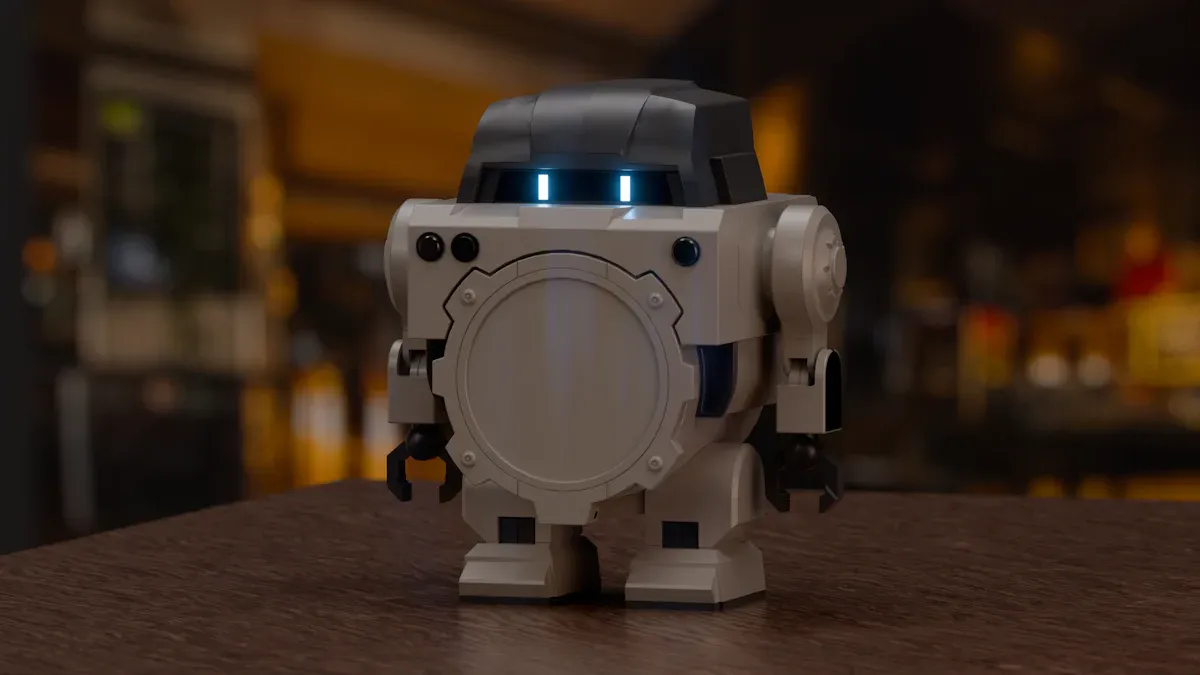
Industrial Automation
Object space machine vision systems play a key role in modern factories. These systems help companies check product quality, guide robots, and keep production lines running smoothly. Many tasks rely on these systems:
- Production quality control, such as defect detection and checking if products meet specifications
- Predictive maintenance by monitoring wear and spotting unusual patterns
- Robot guidance for locating parts, assembly, welding, and material handling
- Sorting and classifying components
- Counting parts quickly and accurately
- Barcode scanning for inventory and logistics
- Inspecting packages and tracking pallets
- Safety monitoring, like checking protective gear and controlling access
These systems automate repetitive tasks and reduce human error. They inspect products at high speed, often reaching over 99.5% accuracy. Factories save money and time because machines work faster than people and do not get tired. The table below shows how these systems improve production efficiency:
| Efficiency Aspect | Impact on Production Efficiency |
|---|---|
| Automation of repetitive tasks | Streamlines operations, allowing focus on higher-value activities |
| Reduction of human error | Enhances throughput and accuracy, minimizing false rejects |
| Speed of vision-guided robots | Processes up to 10,000 parts per hour, accelerating production lines |
| Quality control accuracy | Over 99.5% defect detection accuracy, reducing missed defects |
| Labor cost reduction | Approximately 50% reduction in quality assurance labor costs |
| Downtime minimization | Real-time monitoring enables faster inspections and less downtime |
| Cost savings | Example: $18 million saved annually per production line |
| Sustainability benefits | Reduces energy use and CO2 emissions |
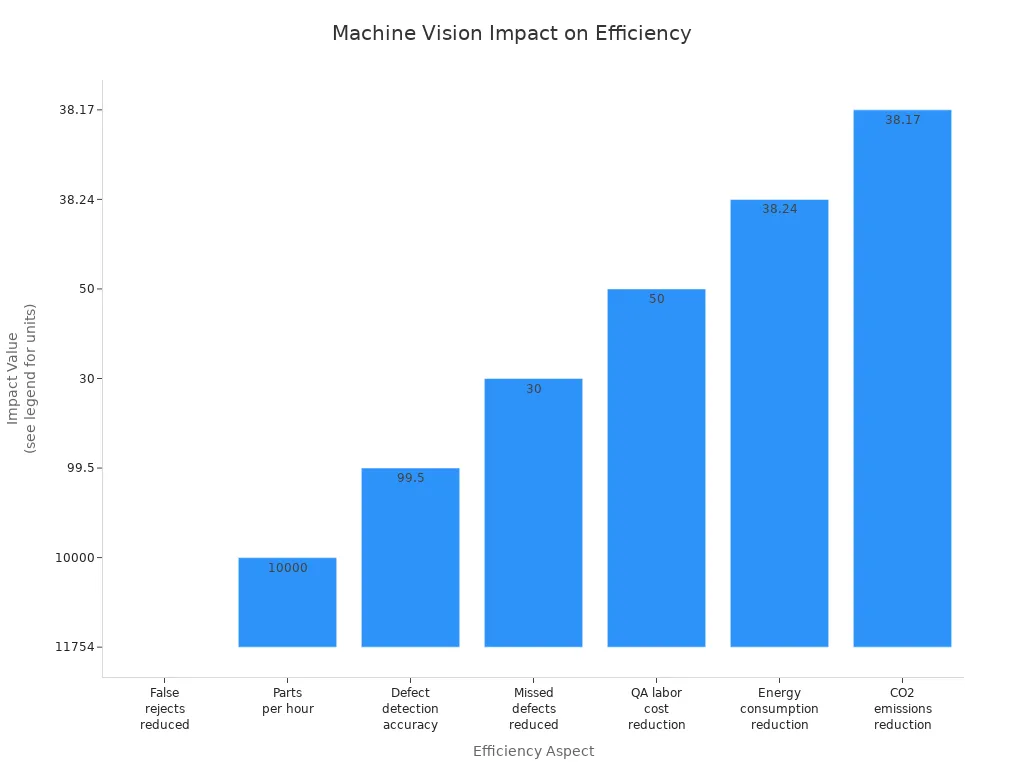
Object space machine vision systems help factories make better products, faster and with less waste.
3D Vision and Robotics
Robots use object space machine vision systems to see and understand their environment. These systems help robots perform tasks that need high accuracy, such as picking up small parts or assembling products. Vision-guided robots use 3D vision to inspect items, detect defects, and ensure quality in real time. They also measure dimensions and align components during assembly.
Object space machine vision systems use different 3D vision technologies. Some use pulsed light and special cameras to capture both range and intensity data. Others use stereo cameras or lasers to map depth. These methods allow robots to build detailed 3D models and perform precise dimension measurement. Real-time feedback helps robots adjust their actions, improving speed and reducing mistakes.
- 3D vision systems create detailed models for inspection and surface defect detection.
- Robots can sort components, detect errors, and increase production speed.
- AI integration makes defect detection more accurate and adaptable.
| Evidence Description | Contribution to Robotics and Autonomous Systems |
|---|---|
| Adaptive 3D reconstruction | Robots can rebuild objects in real time, improving measurement accuracy. |
| Real-time computer vision | Supports smart manufacturing and navigation. |
| Depth perception | Helps robots avoid obstacles and find objects. |
| Stereo vision | Calculates distances and spatial relationships for quality control. |
Space Exploration
Space missions require high-precision tools for navigation, inspection, and research. Object space machine vision systems help spacecraft and rovers measure distances, map surfaces, and detect hazards. These systems provide accurate 3D models of terrain and objects, which is vital for landing, sample collection, and equipment maintenance.
Engineers use these systems to guide robotic arms, inspect spacecraft parts, and monitor the health of equipment. The ability to perform dimension measurement without contact prevents damage to sensitive instruments. Machine vision also supports autonomous decision-making, allowing space robots to react quickly to new situations.
In space, object space machine vision systems enable safe, reliable, and efficient exploration by providing precise data for every mission.
Comparison with Standard Systems
Magnification Differences
Object space machine vision systems and standard vision systems handle magnification in very different ways. Telecentric lenses in object space systems keep magnification steady, even when the object moves closer or farther from the lens. This stability is important for tasks that need exact measurements.
- Telecentric lenses maintain constant magnification within a set object distance range. This removes changes caused by depth.
- Ordinary lenses show magnification changes as the object distance varies. This leads to parallax and measurement errors.
- Telecentric lenses offer better magnification stability. This is critical for high-precision measurement and metrology.
- Standard lenses often have magnification instability, distortion, and parallax effects. These issues make them less suitable for measuring size with accuracy.
- Telecentric lenses correct parallax and keep magnification consistent, unlike standard lenses.
Engineers choose telecentric lenses when they need reliable, repeatable results. Standard lenses work well for general imaging but cannot match the precision of object space systems.
Parallax and Accuracy
Parallax error can cause big problems in measurement. Standard machine vision lenses often show parallax because magnification changes with object distance. This makes closer objects look larger and farther objects look smaller. Object space telecentric lenses solve this problem by design. They keep principal rays parallel to the optical axis, so magnification stays the same within a certain range.
| Feature | Standard Machine Vision Lenses | Object Space Telecentric Lenses |
|---|---|---|
| Parallax Error | Present; causes measurement inaccuracies | Eliminated; constant magnification |
| Magnification Variation | Varies with object distance | Constant within a set range |
| Optical Principle | Rays converge through lens center | Rays parallel to optical axis; no size distortion |
| Suitability for Measurement | Less suitable for high-precision tasks | Ideal for high-precision measurement |
| Cost and Versatility | More cost-effective, versatile | Higher cost, specialized, superior image quality |
Object space machine vision systems also differ in cost and flexibility. They use specialized cameras and lenses, which can cost more upfront but offer lower maintenance and simpler software. Standard systems use general-purpose hardware and complex software, which can increase both initial and ongoing costs. However, standard systems adapt more easily to new tasks.
Tip: For tasks that demand high accuracy and stable measurements, object space machine vision systems provide the best results. Standard systems fit better when flexibility and lower cost matter most.
Object space machine vision systems deliver unmatched precision and speed for measurement and automation. These systems help robots detect tiny defects, measure at the micron level, and adapt to new tasks quickly.
- They reduce human error and improve safety in harsh environments.
- Real-time data processing increases production efficiency and lowers costs.
- Non-contact measurement protects delicate parts and ensures repeatable results.
High-accuracy industries rely on these systems for reliable inspection, quality control, and advanced imaging. Companies seeking consistent, objective, and fast measurements should consider object space machine vision for their next project.
FAQ
What makes an object space machine vision system different from a regular vision system?
Object space machine vision systems use telecentric lenses to keep image size and shape constant. Regular systems often show changes in size when objects move. This difference helps engineers get more accurate measurements.
Why do engineers choose telecentric lenses for measurement tasks?
Telecentric lenses remove perspective errors. They keep magnification steady, even if the object moves. This feature helps engineers measure parts with high accuracy and repeatability.
Can object space machine vision systems work in 3D applications?
Yes, these systems support 3D vision. They help robots and machines build detailed models, measure depth, and inspect complex shapes. This ability improves automation and quality control.
How does lighting affect measurement accuracy in these systems?
Lighting changes can cause shadows or glare. These effects may reduce measurement accuracy. Engineers use stable, even lighting and sometimes special lens features to keep results reliable.
See Also
Understanding The Role Of Machine Vision In Automotives
Exploring How Illumination Enhances Machine Vision Systems
Machine Vision Systems For Effective Quality Assurance Processes
A Comprehensive Guide To Image Processing In Machine Vision
How Cameras Function Within Machine Vision Technologies Today







